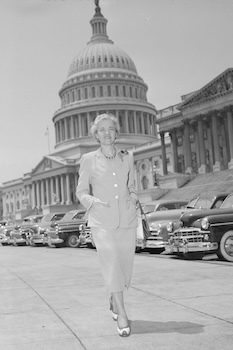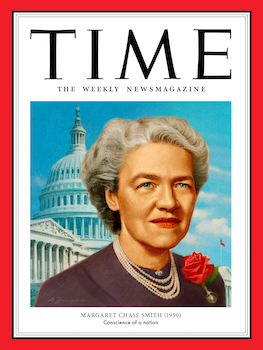
Margaret Chase Smith, known as Margaret Madeline Chase before marriage, was born on December 14, 1897, in Skowhegan, Maine. Smith was born to George Emery, a town barber, and Carrie Murray Chase who served as a store clerk, shoe factory worker, and waitress to provide for her six children. Smith was the oldest of her siblings and therefore the first to graduate from Skowhegan High School in 1916. After graduation, Smith followed her mother’s footsteps and pursued a plethora of careers: teacher, newspaper staff member, telephone operator, and woolen mill office manager. Seven years later, Smith organized and became President of the Skowhegan chapter of the Business and Professional Women’s Club. As seen by her various careers and skills acquired, Smith was incredibly accomplished in her early life and continued to strive for success even after marrying Clyde Harold Smith on May 14, 1930.
Clyde was an accomplished local politician, and in 1936, he was elected to the House of Representatives as a Republican for the 75th Congress. While Clyde worked in the government, Smith managed his affairs at the Washington Office as his secretary, quickly learning the rhythm of life in Congress. In the spring of 1940, during the 76th Congress, Clyde became deathly sick with a heart condition. Soon, he discovered that he wouldn’t be able to survive the rigorous election campaigns, so he persuaded Smith to fill his Republican seat in the House of Representatives. On April 8, Clyde died, but the promise he gave his voters–his wife would continue his unfinished work in office–lived on.

In honor of her husband, Smith took on Clyde’s request and ran in the Republican special primary on May 13 to finish the 76th term; Smith beat her competitor by an astounding 10-1. The high votes ensured her June 3 election victory as Maine’s first female member of Congress. On June 17, Smith entered the House of Representatives for the 77th term with goals to expand the Navy and increase old age pensions. However, Smith quickly became independent of Republican ideals and ran a successful campaign nonetheless. Republicans were firmly opposed to the nation’s involvement in the Cold War, but Smith believed in an aggressive foreign policy, later supporting the Cold and Vietnam wars. In addition, throughout her time in the House, Smith served on a diverse array of committees, including the War Claims Committee, House Naval Affairs Committee, Education Committee, Post Office and Post Roads Committee, and the Armed Services Committee. Therefore, She used her various resources via valuable committee positions and immense popularity to grant Maine shipbuilding projects to increase job opportunities. Smith also served great influence on a global level: she inspected military bases in the South Pacific and observed post-WWII reconstruction in Europe. Smith even passed the Women’s Armed Forces Integration Act, ensuring that the 350,000 women who were enrolled in WWII received their benefits. At the time, the act was controversial due to massive sexism in society and the armed forces, and while the Senate gave approval, the House was much more hesitant. It took Smith calling in her personal friend Secretary of Defense James V. Forrestal to get the act passed and signed by Truman weeks before the forces were racially integrated, highlighting the urgency Smith placed on earning equality for fighting women. Smith served four terms in the House of Representatives and beat all her competitors by at least a 60% margin.

In 1948, Smith retired from the House of Representatives and decided to focus on the elections to the Senate. The campaigning was tough due to her lack of experience in the House, but Smith’s emotional appeal won her a 71% voter victory. Smith’s election to the Senate made her the first woman to serve in both chambers of Congress. She began her 24-year Senate term in 1949 and was the only woman serving in the Senate at the time. Throughout her service, Smith didn’t limit herself to just affairs concerning women; Smith was influentially involved in military and foreign aspects, alongside voicing pro-Civil rights opinions. Smith most famously was against McCarthyism, the persecution of anyone slightly believed to be communist by Senator Joseph McCarthy, in the era entering the Red Scare. On June 1, 1950, Smith gave her well-known “Declaration of Conscience” speech on the matter, emphasizing her belief that citizens have “the right to criticize…right to uphold unpopular beliefs…right to protest.” This speech caused McCarthy to leave the chamber and win Senate support against McCarthyism. In fact, the speech was so influential President Truman invited her for a congratulatory lunch. Smith’s Senate success earned her a place as the first female member of the Appropriations and Armed Services, a committee aimed at budgeting and military control, as well as a position on the influential Space Race panel. With her extensive experience involved in the nation’s politics, Smith decided to expand her career. In 1964, Smith became the first woman to seek a major party’s presidential nomination, but she lost to Barry Goldwater, despite her surprisingly high votes.
In 1973, Smith retired from her political career and moved back to her hometown in Maine. She helped to construct the Margaret Chase Smith Library Center in 1982, instituting the first library to focus on the papers of a woman in Congress. In 1989, President George H. W. Bush awarded her the Presidential Medal of Freedom for her work, the nation’s highest civilian honor given to those who contributed greatly to the nation. Smith died in 1995 on Memorial Day at age 97. Smith left a lasting legacy for female politicians and paved the way for women to be an influential part of Congress. As the first woman to serve in both houses of Congress, Smith solidified strong female influence in the US government.
Why Did I Choose to Research Margaret Chase Smith?
I chose to research Margaret Chase Smith because she was extremely influential in politics and proved that women are worthy members of the national government. As the first woman to be part of the Senate and House of Representatives, Smith openly spoke her views and bettered the lives of those in her home state of Maine. I am deeply inspired by the respect she earned due to her prominence and the way she fought for what she wanted. Smith’s hard work and large impact inspired me to research her.
Works Cited
“Biography.” Margaret Chase Smith Library, http://www.mcslibrary.org/bio Accessed 2024.
Carrie Chapman Catt Center for Women and Politics. “Margaret Chase Smith.” Iowa State University, http://awpc.cattcenter.iastate.edu/directory/margaret-chase-smith/ Accessed 2024.
Editors of Encyclopedia Britannica. “Margaret Chase Smith.” Britannica, 2024, http://www.britannica.com/biography/Margaret-Chase-Smith
“Margaret Chase Smith.” National Women’s Hall of Fame, http://www.womenofthehall.org/inductee/margaret-chase-smith/ www.womenofthehall.org/inductee/margaret-chase-smith/.
“SMITH, Margaret Chase.” History, Art, and Archives United States House of Representatives, http://history.house.gov/People/Detail/21866 Accessed 2024.
This article was published on 7/29/24